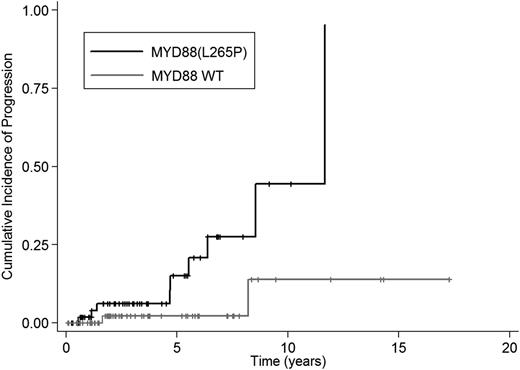To the editor:
MYD88 (L265P) is a recurrent somatic mutation in Waldenström macroglobulinemia (WM).1-4 By means of allele-specific polymerase chain reaction (AS-PCR), the MYD88 mutation is detectable in almost all patients with WM and in roughly half the patients with IgM monoclonal gammopathy of undetermined significance (IgM-MGUS).2,3,5
IgM-MGUS patients have a probability of progression to WM or to other lymphoproliferative disorders (LPD) of ∼1.5% per year, and the initial concentration of the serum monoclonal (M) protein is the main predictor of progression.6
In a case-control study of 77 IgM-MGUS patients, we previously demonstrated that the MYD88 mutation was associated with higher disease burden and with a higher risk of progression to WM or to other LPD.2
We have now analyzed by AS-PCR bone marrow samples, collected at the time of diagnosis, of 136 consecutive IgM-MGUS patients, with the aim to confirm the prognostic role of the MYD88 mutation in a longitudinal study and to evaluate the effect of the MYD88 mutation and of the other potential risk factors in multivariate analysis.
Genomic DNA was extracted from bone marrow mononuclear cells (n = 92) or archival Giemsa-stained slides (n = 44). AS-PCR was performed as previously described.2 Sensitivity of AS-PCR was 0.1%. Cumulative probability of progression was calculated using the Kaplan-Meier product-limit method. The effects of potential risk factors on progression rates were examined in a Cox proportional hazards model.
The MYD88 (L265P) mutation was detected in 71 of 136 patients (52%). Patients were followed for a total of 469 person-years (median, 34 months). During follow-up, 11 of them (8%) progressed to WM (n = 9) or to marginal zone lymphoma (n = 2). Eight of 9 patients who progressed to WM and 1 of 2 patients who progressed to marginal zone lymphoma carried the MYD88 (L265P) mutation at the time of diagnosis of IgM-MGUS. The other 2 patients were MYD88 wild type at diagnosis as well as at progression.
In a competing-risk model considering death for any cause as a competing event, the 5- and 10-year cumulative incidence of progression was respectively 15% and 45% in patients with the MYD88 mutation compared with 2% and 14% in patients with MYD88 wild type (P = .027) (Figure 1). In multivariate analysis, the MYD88 mutation and the concentration of the serum M protein were independent prognostic factors for progression, with a hazard ratio of 5.45 (P = .04) and 3.96 (P < .001), respectively.
Cumulative probability of progression to WM or to other LPDs in patients with IgM-MGUS according to their MYD88 mutational status.
Cumulative probability of progression to WM or to other LPDs in patients with IgM-MGUS according to their MYD88 mutational status.
We constructed a risk-stratification model incorporating the MYD88 mutational status and the concentration of the serum M protein, using a cutoff level of 1.5 g/dL. Forty-seven patients (36%) had none of the risk factors, 64 (48%) had 1 risk factor, and 21 (16%) had both risk factors.
The 5- and 10-year progression rates were respectively 1% and 12% for patients with none or 1 risk factor, compared with 31% and 60% for patients with 2 risk factors (P = .007).
These findings indicate that the MYD88 (L265P) mutation is an independent predictor of progression of IgM-MGUS to WM or to other LPD, irrespective of the concentration of the M protein. The presence of both MYD88 mutation and a serum M protein >1.5 g/dL at diagnosis identifies a subset of IgM-MGUS patients at high risk of progression.
Authorship
Contribution: M.V., L.A. and M.C. designed the research; S.Z. developed the allele-specific PCR and did molecular investigations; E.B. and M.P. reviewed histological diagnosis; S.R., S.M., M.G. and L.P. collected clinical data; and C.P. performed statistical analysis.
Conflict-of-interest disclosure: The authors declare no competing financial interests.
Correspondence: Marzia Varettoni, Department of Hematology Oncology, Fondazione IRCCS Policlinico San Matteo, via Golgi 19, 27100 Pavia, Italy; e-mail: m.varettoni@smatteo.pv.it.


This feature is available to Subscribers Only
Sign In or Create an Account Close Modal